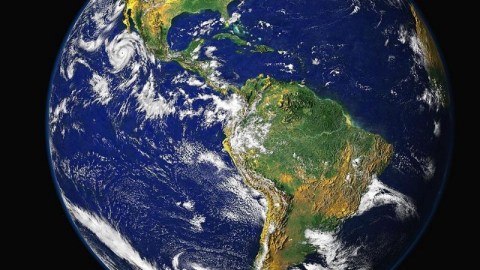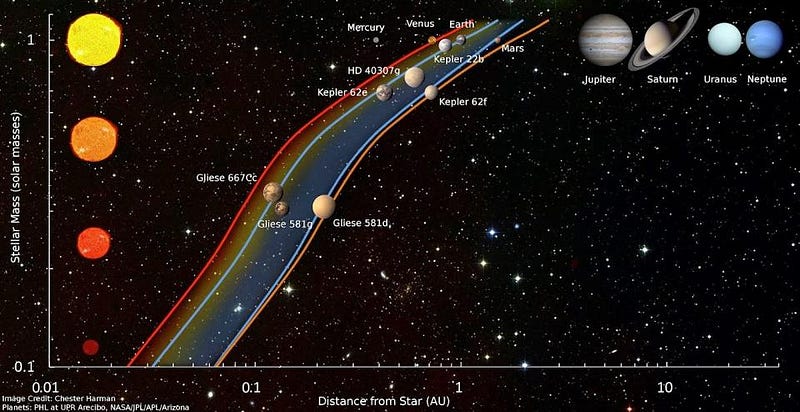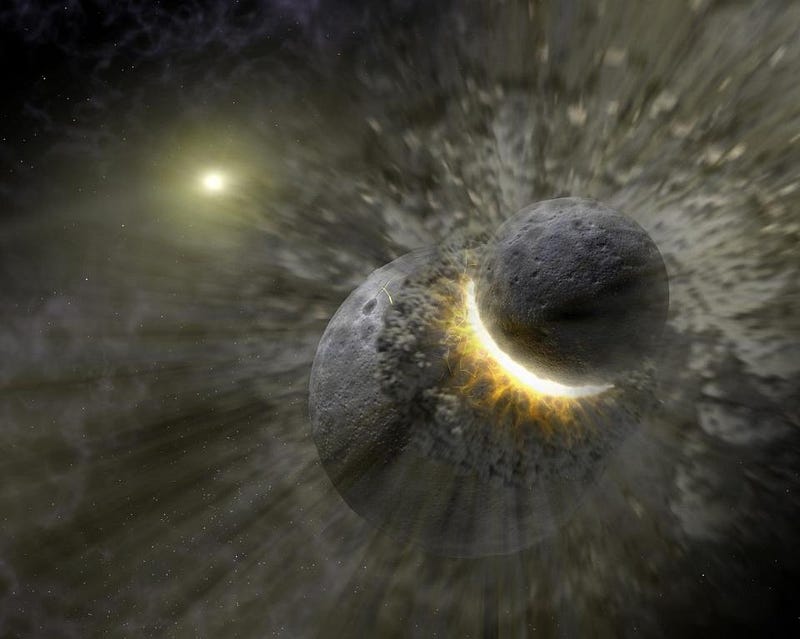Book review: Earth in Human Hands

There’s never been a more important time to be aware of how the fate of the Earth depends on us.
“We only have one planet that serves as an example and in science it’s not good to derive information from a sample size of one.” –David Grinspoon
Throughout the history of Earth, there have been an incredible number of critical moments that determined what direction our planet would take next. Just a few tens of millions of years after the Solar System first formed, a catastrophic collision with a Mars-sized planet wreaked havoc on the entire planet, and created the Moon from its debris. Two billion years later, life almost went extinct as anaerobic organisms, producing oxygen as a waste product, almost poisoned the planet and caused it to freeze over entirely. And every few hundred million years or so, a mass extinction wipes out about half the species living on the globe, including 65 million years ago, with a massive asteroid causing the demise of the dinosaurs.

But these events weren’t simply catastrophes for life across-the-board, but also opportunities for the survivors. For the first time, a single, sentient species — humanity — has their hands on the controls while it’s happening. Quite literally, shaping our planet’s future is something we’re actively doing right now. This is what astrobiologist David Grinspoon explores in his new book, Earth In Human Hands.

Grinspoon, an accomplished astrobiologist and a former student of Carl Sagan’s, lays out the scientific case remarkably well. We don’t normally think about our Solar System as having more than one world in its habitable zone, yet 4.5 billion years ago, we had four: Venus, Earth, Theia and Mars. If you’ve never heard of the Mars-sized world Theia, it’s because it isn’t around any longer! Tens of millions of years after the rest of the Solar System settled down, Theia collided with Earth, forming the planet we call home and also kicking up debris that gave rise to the Moon.

In the aftermath, there were three worlds — Venus, Earth and Mars — that had very similar beginnings.
- All three had substantial amounts of liquid water on their surface.
- All three had all the raw ingredients, and perhaps some relatively advanced ingredients, for life.
- And all three had active geologies, volcanoes, atmospheres, weather and more.
For hundreds of millions of years, and on Mars, perhaps for more than a billion years, there were multiple chances for life to evolve and thrive as it has here on Earth.

Yet only Earth made it. All three worlds saw their climates change naturally, due to a few processes that we know of and a few others that are uncertain. Grinspoon lays out clearly and competently what we know about Venus and its runaway greenhouse effect, what we know about Mars and how it lost its magnetic field and had its atmosphere stripped away, and what we know about Earth, and how our world survived, sometimes only barely, our early challenges.

The whole difficulty with Earth today, Grinspoon argues, is that we only get one. We don’t have the luxury of experimenting the way most scientists are accustomed to, by experimenting with controls and incremental changes, and quantifying the results. We also can’t do it the way astronomers do, by surveying and observing huge numbers of similar systems. We only get the one. He details what we know from the budding science of comparative planetology (many of these fields have a variety of names), planetary geology, atmospheric sciences and more. It’s remarkable how much we don’t understand about the world, yet the effects humans have already had on Earth are monumental.

Earth in Human Hands really makes you think about the planetary need for (and benefits of) geoengineering. There are a wide variety of scientists who think about that only as a “last ditch” effort to fight climate change, when all the ounce-of-prevention solutions have failed. Yet humans have already had a tremendous effect on our atmosphere, on our land use, on our water cycle, on the rivers, lakes, canals and bodies of freshwater, on the oceans and much more. We might not call it geoengineering because it wasn’t intentional, but the effects of our collective actions over the past 10,000 years are undeniable. Grinspoon provides possibilities, not all of which will turn out to be solutions, for addressing the ramifications of what we’ve already done and what we’re continuing to do. It’s a fascinating problem to consider.

Grinspoon is at his strongest when he really digs into the science. Forty years ago, there was no such field as astrobiology. The scientists who came together to ask about the possibility of life on other worlds were astronomers, physicists, meteorologists, geologists, hydrologists, chemists and more. They each brought their own expertise and had to learn a tremendous amount from outside fields, and led to the picture that Grinspoon presents in this work of where Earth stands today in the scheme of the great cosmic possibilities. If you’re interested in learning the bleeding-edge science of how the Earth has come to be the way it is today — over its 4.5 billion year history and particularly over the last 10,000 years — this book is for you.

This book could have strongly benefited from an editor who wasn’t afraid to make cuts, however. Grinspoon goes to great lengths, right in the first few pages, to announce that this is a book about what we know, and that all of these facts would have come to light because of the process of science, irrespective of the genius or personalities of the scientists who made these findings. If he had stuck to that, this book could have been about 150 pages shorter, and probably twice as exciting to read! Instead, we are treated to a “who’s who in astrobiology,” which is likely only interesting to present and aspiring astrobiologists.

In addition, he doesn’t seem to go more than about five pages at any point without bringing up “Uncle Carl,” including long excursions about Grinspoon’s personal history with Carl Sagan, Carl Sagan’s former grad student, Carl Sagan’s correspondence, and Carl Sagan’s legacy. Then, years after Carl Sagan’s death, he was awarded the Sagan Medal for science communication by a planetary scientist.
But we didn’t all grow up with parents who were Cornell professors and friends with Carl Sagan. We didn’t all go to Cornell and work with Carl Sagan, then continue our studies and go work under Carl Sagan’s former students. It leaves one with the distinct impression that this is how Grinspoon takes for granted how one becomes a scientist: you’re born with the right connections and start when you’re six-years-old. There’s nothing wrong with the fact that this is his story, but unless you’re a Carl Sagan superfan who grew up with similarly privileged circumstances, it might send the (incorrect and damaging) message that this is the path to a successful scientific career.

None of the personal stories, the academic history or the Sagan-admiration take away from the book’s central message for long, however. Grinspoon always returns to the main character in this story: Earth. Earth in Human Hands is a remarkable synthesis of natural history, planetary science, extinction histories, Earth’s climate and the human effect on the world. The evidence is laid bare for all to see, and by time you’re finished with the book, you feel not only a sense of urgency, but a sense of shared responsibility.

We truly are living in the anthropocene era, as Grinspoon argues, as more than any other factor, it’s humanity that’s driving the major changes in Earth’s environment and, for many species, its habitability. This world is the only home we know, and it’s up to all of us, together, to make it a good one for not only ourselves, but for all the humans, animals and other living creatures who’ll come after us. If we do it right, the 21st century won’t be the peak of human achievement, but rather our initial foray into a brilliant, uncertain but full-of-potential future.
Earth in Human Hands by Dr. David Grinspoon goes on sale December 6th.
This post first appeared at Forbes, and is brought to you ad-free by our Patreon supporters. Comment on our forum, & buy our first book: Beyond The Galaxy!





